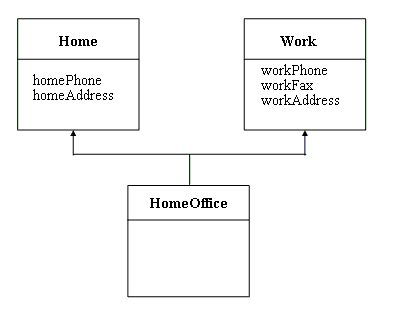C++ Mutliple Inheritance
Sometimes a class could be derived from more than one base class, and it is called multiple inheritance. For example, a class HomeOffice may be derived from both classes of Home and Work. The following diagram corresponds to the class hierarchy:
Part of the declarations and definitions of the classes are as follows:
/*****************************************************/
/* declaration of the base class Home */
/*****************************************************/
class Home
{
protected:
char* homePhone;
char* homeAddress;public:
Home(int hp, char* ha);
~Home();
void print();
};/*****************************************************/
/* declaration of the base class Work */
/*****************************************************/
class Work
{
protected:
char* workPhone;
char* workFax;
char* workAddress;public:
Work(int wp, int wf, char* wa);
~Work();
void print();
};/******************************************************/
/* declaration of the derived class HomeOffice */
/******************************************************/
class HomeOffice : public Home, public Work
{
public:
HomeOffice(const char* const hp, const char* const ha,
const char* const wp, const char* const wf,
const char* const wa);
void print();
};/******************************************************/
/* implementation of the constructor of derived class HomeOffice */
/******************************************************/
HomeOffice::HomeOffice(const char* const hp, const char* const ha,
const char* const wp, const char* const wf,
const char* const wa)
: Home(hp, ha), Office(wp, wf, wa)
{}
Improper use of multiple inheritance might introduce ambiguities.
 |
what properties class D actually inherits from its superclasses B and C. 3 Possibilities:
|
